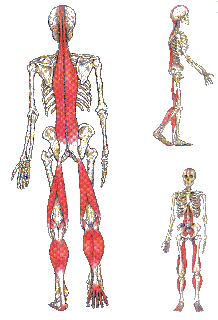I am a big fan of the deadlift (done properly- often it isn't). If you come to one of my group training sessions or train with me, just about everyone will learn how to perform a PROPER deadlift (I have a few clients that don't because certain situations or injuries). First of all, lets see a deadlift, so we all know what I am talking about. In the video below, I am sumo (a type of deadlift where feet are wider than the hands) deadlifting. Note: the lack of shoes makes it easier, grunting is optional.
405 x 3 Deadlift from Dan Hubbard on Vimeo.
Deadlifting is simply lifting something up from a position (commonly the ground) in front of you. It is a pretty basic human movement and performed on a daily basis. But, here is where it gets interesting, training the deadlift does two important things. First, it strengthens the "anti-gravity" muscles that atrophy, stretch, and weaken as a consequence of living in our modern, sedentary environment. Secondly, It teaches you how to "move properly." I will explain that more. Lets just say that most people don't move properly and its a function of sitting a lot, and just not knowing how to move properly.
Dissecting the Deadlift.
While there are several variations of the deadlift, such as: the Conventional, Sumo, Romanian, Stiff-Legged, Snatch-Grip, Single-Legged deadlift. They all have some common elements:
 |
| Maintain a "neutral" spine. |
"Individuals performing upright, resisted, dynamic exercises can achieve high trunk muscle activation and thus may not need to add instability device exercises to augment core stability training. " (Hamlyn N, Behm DG, Young WB., 2007)
2. The primary movement is a 'hinging' of the hips and is taught by telling a client to 'sit back' into the deadlift. The muscles that extend the hips (glutes and hamstrings) are usually weak. The deadlift builds the strength of these muscles.
 |
| Sit back into the deadlift. |
3. Bar stays close to the body and moves from the upper thigh level down to various levels (depending on the type of deadlift), most commonly until the weight plates touch the ground, then back up.
Learning How To Move Well
 |
| Some of the "anti-gravity" muscles |
When learning how to deadliftt, a client learns how to simultaneously brace the torso and hinge through the hips. Once that pattern is established, then they learn how to 'load their hips' properly. That is, keep the stress on the hip muscles as you lift the weight. This allows you to properly strengthen these muslces.
As the resistance increases, the torso-stabilizing muscles must also be able to maintain the neutral spine. If the deadlift is progressed properly, it will develop all of the torso-stabilizing muscles, in addition to the hips.
Below, one of my female clients performs a set of deadlifts during a group training session.
Claudia 101lbx5 Deadlift from Dan Hubbard on Vimeo.
Claudia sets a new personal record on the deadlift.
Deadlifting is a very effective and practical movement that, done correctly, is very safe and a highly effective method of developing torso, grip, and hip strength. Unfortunately, the deadlift is not utilized often because proper technique is essential and needs to be learned. But, in the process of training the deadlift, you will strengthen the "anti-gravity" muscles and learn to move well.
 |
| Nia is pretty strong |
If you are a female who has never deadlifted before, check out Why Women Should Deadlift, by Nia Shanks.
If you are interested in learning more about proper deadlifting technique, here is a great article by Mark Rippetoe.


2 comments:
What do you say to people who claim that deadlifts are so physically taxing (especially to the spinal-stabilization muscles during heavy, low reps) they should only be used once per week (if that)?
Is this just for big powerlifters lift heavy and always try to improve, or can fitness lifters deadlift more often? Thanks.
Thanks for your question, Tom. The spinal stabilizers do work very hard during the deadlift, especially heavy deadlifts. There is not a 'yes' or 'no' answer to your question because there are many variables involved, such as: training age, goals, recovery, total training volume, type of periodization (if any) being used, etc. However, personally, I cannot perform heavy (1-5 rm range) more frequent than once per week. I do use an undulating periodization for myself. Also, I cycle several deadlifting-type of exercises (single-leg, snatches, back squats, kettlebell snatches and cleans, etc.). This type of programming is in-line with my goals of developing strong and powerful hips for sports (basketball and cycling), not to compete in powerlifting. While deadlifting is a good exercise, as a general strength training enthusiast, I would employ several types of hip exercises. Heavy deadlifting is very taxing (which means it demands full attention) and the average, drug-free lifter needs to listen to his body and probably periodize his training for optimum results.
Post a Comment